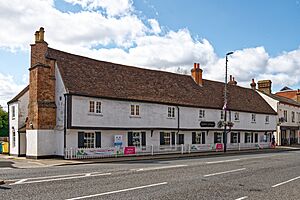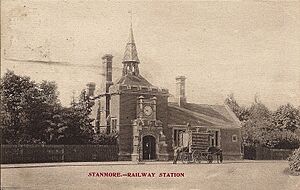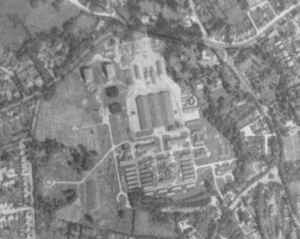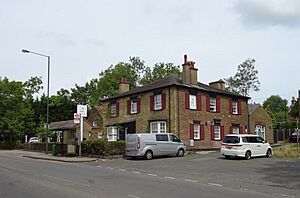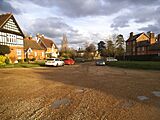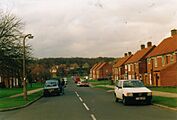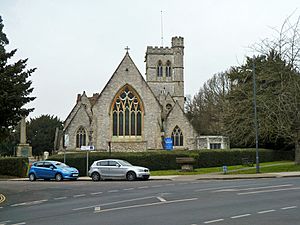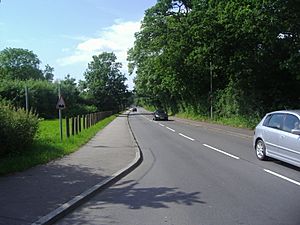Stanmore facts for kids
Quick facts for kids Stanmore |
|
|---|---|
 Pump at one of the Roman-era ponds at Little Common, which gave Stanmore its name |
|
| Population | 23,700 (Stanmore Park and Canons wards 2011) |
| OS grid reference | TQ1691 |
| London borough | |
| Ceremonial county | Greater London |
| Region | |
| Country | England |
| Sovereign state | United Kingdom |
| Post town | STANMORE |
| Postcode district | HA7 |
| Dialling code | 020 |
| Police | Metropolitan |
| Fire | London |
| Ambulance | London |
| EU Parliament | London |
| UK Parliament |
|
| London Assembly |
|
Stanmore is a town in the London Borough of Harrow in Greater London, England. It is located about 11 miles (18 km) northwest of central London. Stanmore is on the edge of the London urban area. It is home to Stanmore Hill, which is one of the highest points in London. This hill is 152 meters (499 feet) high.
Stanmore grew from two old areas called Great and Little Stanmore. It is just west of the old Roman road, Watling Street (now the A5 road). Today, Stanmore makes up the eastern part of the London Borough of Harrow.
Stanmore was once the site of RAF Bentley Priory. This was an important air force base during both World Wars. It was the headquarters for RAF Fighter Command. The base included the grand Bentley Priory mansion. This mansion was the last home of Queen Adelaide.
Over time, Stanmore became a London suburb. In the past, it housed the regional offices for the Automobile Association. Today, Stanmore is a commuter town. Many people live here and travel to work in London. It has a tube station which is the last stop on the Jubilee line. Stanmore also has many large green spaces.
Contents
What's in a Name?
The name "Stanmore" was first written down in a document from 793 AD. This was when land in Stanmore was given to St Albans Abbey. In the Domesday Book of 1086, the two areas of Stanmore were called Stanmere.
The name comes from old English words. Stan means 'stony' and mere means 'a pool'. There are rocky areas and gravel in the clay soil here. The 'mere' or pool that gave Stanmore its name might have been one of the ponds that still exist today. One of these ponds, on Stanmore Common, is sometimes called Caesars Pond. People believe a battle happened nearby in 54 BC.
Stanmore's Past
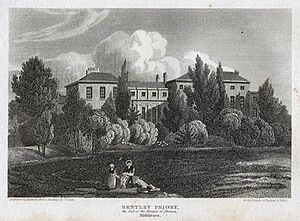
Roman Times
On Brockley Hill, near the Royal National Orthopaedic Hospital, there is an obelisk. This stone pillar marks where a battle is thought to have happened. It was between Julius Caesar's Roman soldiers and the local Catuvellauni tribe. The tribe was led by Cassivellaunus. This battle is said to have taken place in 54 BC, when Caesar raided Britain.
Britain was later conquered by the Romans in 43 AD. After this, the Romans built a local settlement called Sulloniacis in the area.
Early Stanmore: Manors and Parishes
The area known as Stanmore was first mentioned as a 'manor' (a large estate) in 793 AD. The Domesday Book of 1086 describes two existing manors, Great and Little Stanmore. These estates changed owners after the Norman Conquest. They were later served by the old church areas called 'ancient parishes'.
Before Stanmore Became a Town
Until the late 1800s, Stanmore was a small farming community. In the Middle Ages, a group of monks called Augustinian Canons lived at Bentley Priory. Their monastery was closed in 1536. This happened during the time when many monasteries were shut down.
One of the oldest buildings still standing is the Cottrell Cottages, built around 1565. This suggests that in medieval times, the main part of Stanmore was around what is now The Broadway. Later, in the late 1700s, more buildings were developed on Stanmore Hill.
Grand Houses of Stanmore
Between 1713 and 1724, the 1st Duke of Chandos built a huge house called Cannons in Little Stanmore. A few years later, in 1729, Andrew Drummond bought Stanmore House and the Stanmore Park estate. He was a banker and used it as his country home.
A new mansion was built for Andrew Drummond at Stanmore Park in 1763. It was designed in a grand style by famous architects. The Drummond family was even painted in the grounds by the artist Zoffany. Later, the Drummonds rented Stanmore House to other important people. The Marquess of Abercorn bought the estate, along with Bentley Priory, in 1839.
In 1848, Stanmore House was sold again. It was later used as a school for boys. The house was pulled down in 1938. The land was then used by the Royal Air Force for their Balloon Command headquarters. Street names like Lady Aylesford Avenue and Abercorn Road remind us of the area's history. RAF Stanmore Park closed in 1997 and is now a housing estate.
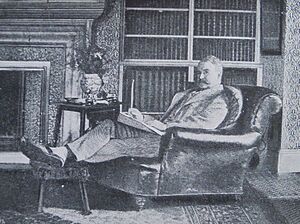
In 1775, a wealthy businessman named James Duberley asked Sir John Soane to design a large mansion. This house was built north of the original Bentley Priory. It was made bigger over the 1700s and 1800s by different owners. It was greatly expanded in 1788 for John Hamilton, 1st Marquess of Abercorn.
The Priory was the last home of Dowager Queen Adelaide. She was the queen of William IV. She died there in 1849. In 1882, a hotel owner named Frederick Gordon bought Bentley Priory. He turned it into a country house hotel for rich guests.
The writer of opera songs, W. S. Gilbert, lived at Grim's Dyke. This country house is between Stanmore and Harrow Weald. In 1911, Gilbert drowned in the pond at Grim's Dyke. His body was cremated, and his ashes were buried at St. John's Church in Stanmore.
Stanmore Becomes a Suburb
Trains first came to Stanmore in 1890. Frederick Gordon built the Stanmore branch line to make it easier to get to Bentley Priory. He hoped this would bring more wealthy customers to his hotel. The local council for Great Stanmore said that Gordon's new station must be very high quality. So, Stanmore station (later called Stanmore Village) was designed to look like a small English church. It even had a spire and gargoyles.
The trains were run by the London and North Western Railway (LNWR). Gordon also bought land near the station. He built a wide road called Gordon Avenue. It was lined with new, fancy houses. He hoped to attract rich Londoners to live in the countryside and travel to the city by his new railway.
Despite his efforts, Gordon's businesses in Stanmore were not very successful. In 1899, he sold the railway. Gordon died in 1904. His body was brought back to Stanmore and buried in the family grave at St. John's Church.
In the early 1900s, London's population grew. Stanmore started to change from a small village into a London suburb. In December 1932, the Metropolitan Railway (MR) opened a new electric railway. It had a station at Stanmore. This is now the London Underground station on the Jubilee line.
This new, fast route into London was strong competition for Gordon's old railway. Passengers on the old line had to change trains to get to London. After years of fewer passengers, Stanmore Village station was closed in 1952.
War and After
During World War II, Stanmore played a key role. Stanmore had a secret outpost from Bletchley Park. This was where some of the special machines called Bombes were kept. These machines helped decode German messages from the Enigma machine. RAF Bentley Priory was taken over by the RAF. In 1940, the famous Battle of Britain was controlled from there. RAF Bentley Priory closed in 2009.
In the 1950s, the Automobile Association (AA) built a large office building in Stanmore. This became the AA's main office for London and the South East. It was a big employer in Stanmore. The center once handled up to 3,000 calls a day. In 1986, the AA moved to a new building nearby.
The old, empty building became run down. It was damaged by vandals and graffiti. There were plans to build a shopping center there, but they didn't happen. The building was left empty for years before it was pulled down in 1993. The site stayed empty for a few more years. Then, Sainsbury's built a supermarket there, which opened in late 1999.
The Bernays Memorial Institute was saved from being pulled down. It was restored over 18 years, finishing in 2009. The AA call center closed in 1997. It moved its main office to Basingstoke. In 1999, it was announced that the breakdown center would also close. This meant 140 jobs were lost, ending the AA's long connection with Stanmore. After being sold by the AA, the building was used by Carpetright and as offices.
Stanmore's Churches
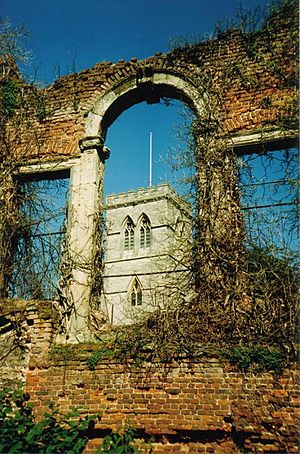
The first church in Stanmore was St Mary's, built in the 1300s. It was on the site of an even older wooden church from Saxon times. This Saxon church might have been built where a Roman shrine once stood. St Mary's church has now completely disappeared. Only one tomb from it remains in a garden.
This building was replaced by a new church. It was built in the current churchyard and opened in 1632. It was named after St John the Evangelist. This brick church was blessed by Archbishop Laud. It is one of the few churches built in Britain between the medieval period and the 1700s.
By the 1800s, this church was seen as old-fashioned and unsafe. After a new church was built, its roof was removed, and it became a ruin.
A brand new church was built in the Gothic Revival style from 1849 to 1850. Queen Adelaide made her last public appearance to lay the first stone for this new church. She gave the church its font (a basin for baptisms). When the church was finished after her death, the east window was dedicated to her memory.
Stanmore Hall
Stanmore Hall was built in the 1840s. It is a Grade II* listed building, meaning it's very important historically. It was built like a gothic castle. Located on Wood Lane near the top of Stanmore Hill, it was owned by balloonist Robert Hollond and his wife Ellen Hollond. They lived there for the rest of their lives. The inside of the hall was redesigned by William Morris later in the century.
William Knox D'Arcy lived at the Hall and died there in 1917. He was one of the first people to explore for oil. Important people attended D'Arcy's funeral. His coffin was carried from the hall through the village to St John the Evangelist for the service.
After D'Arcy's death, Stanmore Hall was sold. It was no longer used as a family home. During the Second World War, it was used by the Allied Expeditionary Air Force. After the war, until 1971, it was a home for nurses from the Royal National Orthopedic Hospital.
Stanmore Hall has been used as a place for filming movies and TV shows. These include the British films Frankenstein Must Be Destroyed and Nothing but the Night. It was also used for 1960s TV series like The Avengers and later The Professionals.
Over time, the building was not looked after well. Its structure got worse, and it was damaged by a fire in 1979. Finally, in 1998, the Hall was turned into separate luxury homes by a developer.
Stanmore Today
Many people who live in Stanmore travel to jobs in central London. This helps make the area quite wealthy.
Shops and Places to Eat
Central Stanmore has many shops, pubs, and restaurants. These range from small local businesses to large chain stores.
Green Spaces
Stanmore Park is at the bottom of Stanmore Hill, next to the local library. Bentley Priory Nature Reserve, Stanmore Common, and Stanmore Country Park are larger parks and nature reserves. The Stanmore Tourist Board encourages people to visit these places and other attractions like the Bernays Gardens.
Further south is Stanmore Marsh. This area of wetlands, grassland, and woodland used to dry out. But a project finished in 2017 restored it. Here, a small stream called a tributary of the Stanburn Brook becomes the Edgware Brook. It then flows east towards Edgware.
Sports Clubs
On the border with Bushey is Stanmore Cricket Club. It is one of the oldest clubs in the Middlesex county championship league. The club celebrated 150 years in 2003. Two famous cricketers who played for England, Angus Fraser and Mark Ramprakash, were trained at this club.
Schools in Stanmore
Stanmore has several schools. These include Avanti House Primary and Secondary Schools, Park High School, Bentley Wood High School, Stanmore College, and the North London Collegiate School.
Homes in Stanmore
People of Stanmore
In 2011, the population of Stanmore Park ward (a local area) was 11,229. The Canons ward, which includes the railway station and eastern areas, had 12,471 people.
Stanmore has many different communities. These include Christian, Muslim, Hindu, Jain, and Jewish people. There is a local synagogue, Stanmore and Canons Park Synagogue, which is one of the largest in Europe. There is also an Islamic center and a new Hindu temple.
The 2011 census showed that in Stanmore Park ward, 56% of people were white. 20% were Indian. 31% were Christian, 22% Jewish, 15% Hindu, and 11% Muslim. In Canons ward, 52% were white and 24% were Indian. 26% were Christian, 25% Jewish, 18% Hindu, and 11% Muslim.
Famous People from Stanmore
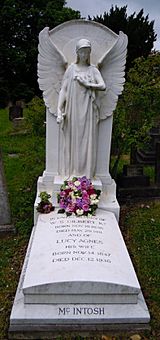
- Queen Adelaide (1792–1849), queen of William IV, lived at Bentley Priory from 1848 until her death.
- George Hamilton-Gordon, 4th Earl of Aberdeen, a Prime Minister of the UK, grew up in Stanmore and is buried there.
- Frederick Gordon, a hotel owner who built the first Stanmore railway.
- W. S. Gilbert, a famous English writer of plays and opera songs. He lived at Grim's Dyke and died in the lake there. His ashes are buried in Stanmore.
- Robert and Ellen Hollond lived here. Robert was a balloonist and a Member of Parliament. Ellen started London's first créche (daycare center).
- Clement Attlee, a Labour Prime Minister after World War II.
- Chaz Jankel, a singer and musician, was born in Stanmore.
- Billy Idol, a rock musician, was born in Stanmore.
- Anthony Horowitz, a writer and screenwriter, was born in Stanmore.
- Roger Moore, an actor famous for playing Simon Templar in The Saint and later James Bond.
- Theo Walcott, a footballer, was born in Stanmore.
- William Knox D'Arcy lived and died at Stanmore Hall.
- Matt Lucas, a performer and comedian, grew up in Stanmore.
- Alexis Sánchez, a footballer, lived in Stanmore while playing for Arsenal F.C.
Getting Around Stanmore
Roads
The A410 road runs east to west through Stanmore. To the west, it goes towards Harrow Weald and Hatch End. To the east, it meets the A5 at Canons Corner roundabout. This connects to the M1 motorway and Central London. A short distance east is a junction for the A41 main road.
Marsh Lane and Honeypot Lane go south towards Queensbury. Stanmore Hill and The Common go towards Bushey Heath and then to Watford.
Nearby Places
- Elstree
- Borehamwood
- Edgware
- Bushey
- Watford
- Harrow Weald
- Belmont
Tube and Trains
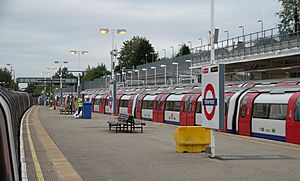
Stanmore is the northern end of the Jubilee line. This gives the area a direct London Underground link to Central London. The old Stanmore branch line to Harrow & Wealdstone station closed in 1964.
Bus Routes
| Route | Start | End | Operator |
| 142 | Brent Cross | Watford Junction | London Sovereign |
| 324 | Elstree | Brent Cross Tesco | Metroline |
| 340 | Edgware | Harrow | Arriva London |
| H12 | Stanmore | South Harrow | London Sovereign |
| 79 | Edgware | Alperton Sainsbury's | London Sovereign |
| 107 | Edgware | New Barnet | Metroline |
| 186 | Brent Cross | Northwick Park Hospital | Metroline |
| H18/H19 | Harrow | Harrow | London Sovereign |
| N98 (Night) | Stanmore | Holborn | Metroline |
See also
 In Spanish: Stanmore para niños
In Spanish: Stanmore para niños
|



